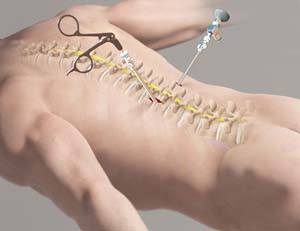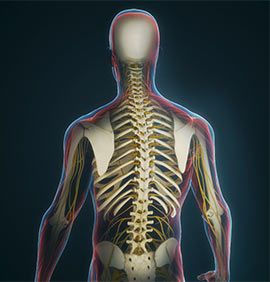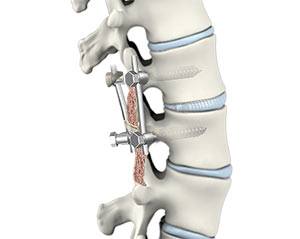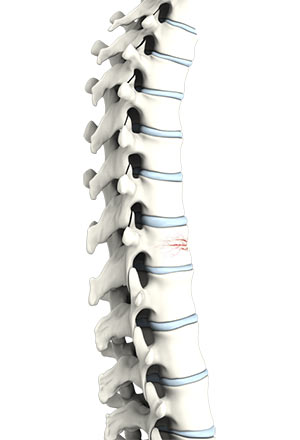-
 Minimally Invasive Spinal Surgery
Minimally Invasive Spinal Surgery
Minimally invasive spine surgery (MISS) is the latest technology available to perform spinal surgeries through small, less than one-inch-long incisions. It involves the use of special surgical instruments, devices and advanced imaging techniques to visualise and perform the surgery through such small incisions.
Know More -
 Advanced Pain Management
Advanced Pain Management
Advanced pain management techniques may be recommended for severe chronic pain. Pain may be temporary or persistent. Pain which lasts several months is called chronic pain.
Know More -
 Laser Disc Surgery (PLDD)
Laser Disc Surgery (PLDD)
Percutaneous discectomy is a minimally invasive technique in which the herniated disc material is removed through a very small cut made in the skin. Herniated disc is a condition in which the outer fibers (annulus) of the intervertebral disc are damaged causing the soft inner material of the nucleus pulposus to rupture out of its space.
Know More -
 Spinal Epiduroscopy (Endoscopy)
Spinal Epiduroscopy (Endoscopy)
Endoscopic spine surgery is a minimally invasive spine surgery that uses specialised video cameras and instruments to remove the herniated disc through very small incisions.
Know More -
 Regenerative & Stem Cell Service
Regenerative & Stem Cell Service
Stem cell therapy is a form of regenerative medicine that utilises the body’s natural healing mechanism to treat various conditions. Stem cells are being used in regenerative medicine to renew and repair diseased or damaged tissues and have shown promising results in treatments of various orthopaedic, cardiovascular, neuromuscular and autoimmune conditions.
Know More -
 Non-Surgical & Rehabilitation Service
Non-Surgical & Rehabilitation Service
Non-surgical and rehabilitation services include medications, exercise, physical therapy, acupuncture, weight loss and smoking cessation. Your rehabilitation team would comprise physiotherapists, orthopedic doctors and massage therapists to improve your flexibility through various physical activities and exercises.
Know More -
 Back Pain
Back Pain
Back pain or backache is the pain felt in the back that may originate from damage to the muscles, nerves, bones, joints or other structures in the spine. Back pain is one of the most common medical problems experienced by most people at some time in their life. It can be acute, usually lasting from a few days to a few weeks, or chronic, lasting for more than three months.
Know More -
 Kyphoplasty
Kyphoplasty
Balloon kyphoplasty is a spine surgery that relieves back pain caused by a vertebral compression fracture. The aim of balloon kyphoplasty is to relieve pain, stabilize the fracture and restore the vertebral body height.
Know More -
 Spinal Fusion
Spinal Fusion
Spinal fusion is the surgical technique of combining two or more vertebrae. A fusion of the vertebrae involves the insertion of secondary bone tissue obtained either from an autograft (tissues from your own body) or allograft (tissues from another person) to enhance the bone healing process.
Know More -
 Spinal Stenosis
Spinal Stenosis
Spinal stenosis usually affects the cervical and lumbar spine. If the spinal canal is narrowed, the disorder is called cervical/lumbar central stenosis. If the foramen is narrowed, it is referred to as cervical/lumbar foraminal stenosis.
Launch Movie Know More -
 Radiofrequency Denervation (Radiofrequency Ablation)
Radiofrequency Denervation (Radiofrequency Ablation)
Radiofrequency ablation (RFA), also called rhizotomy or neurotomy, is a novel non-surgical technique of treating pain. This technique employs radiofrequency waves to produce heat and the heat produced damages the nerves transmitting pain signals to the brain. This procedure is performed to treat painful facet joints in the spine that usually cause chronic low back pain and neck pain.
Know More -
 Spinal Ozone Therapy
Spinal Ozone Therapy
Coming Soon
Know More -
 Spinal Injections
Spinal Injections
Spinal injections are used to inject medications into the painful/injured area of the spine. Spinal injections can be used to diagnose (diagnostic) the cause of pain as well as treat (therapeutic) it. There are different types of spinal injections, often referred to as spinal blocks.
Know More -
 Vertebroplasty
Vertebroplasty
Vertebroplasty is a minimally invasive procedure performed to reduce or eliminate pain caused by a vertebral compression fracture. It stabilises the fracture and prevents further collapse of the vertebra, averting deformity.
Know More -
 Physiotherapy
Physiotherapy
Physical therapy (PT) is an exercise program that helps you improve movement, relieve pain, encourage blood flow for faster healing, and restore your physical function and fitness level. The main goal of physical therapy is to make your daily activities such as walking, getting in and out of bed, or climbing stairs easier.
Know More -
 Osteopathy
Osteopathy
Osteopathic medicine is a patient-centred, holistic, hands-on approach to diagnosing and treating illness and injury.
Know More
General Spine
Office Hours
WEEKDAYS 09:00 AM – 8:00 PM
WEEKENDS 10:00 AM – 4:00 PM
Are You Ready for a Consultation?
Schedule your appointment now!

